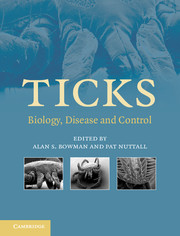Book contents
- Frontmatter
- Contents
- List of contributors
- Preface
- 1 Systematics and evolution of ticks with a list of valid genus and species names
- 2 The impact of tick ecology on pathogen transmission dynamics
- 3 Tick salivary glands: the physiology of tick water balance and their role in pathogen trafficking and transmission
- 4 Tick saliva: from pharmacology and biochemistry to transcriptome analysis and functional genomics
- 5 Tick toxins: perspectives on paralysis and other forms of toxicoses caused by ticks
- 6 Tick lectins and fibrinogen-related proteins
- 7 Endocrinology of tick development and reproduction
- 8 Factors that determine sperm precedence in ticks, spiders and insects: a comparative study
- 9 Tick immunobiology
- 10 Saliva-assisted transmission of tick-borne pathogens
- 11 Lyme borreliosis in Europe and North America
- 12 Viruses transmitted by ticks
- 13 Babesiosis of cattle
- 14 Theileria: life cycle stages associated with the ixodid tick vector
- 15 Characterization of the tick–pathogen–host interface of the tick-borne rickettsia Anaplasma marginale
- 16 Emerging and emergent tick-borne infections
- 17 Analysing and predicting the occurrence of ticks and tick-borne diseases using GIS
- 18 Acaricides for controlling ticks on cattle and the problem of acaricide resistance
- 19 Anti-tick vaccines
- 20 Anti-tick biological control agents: assessment and future perspectives
- 21 Pheromones and other semiochemicals of ticks and their use in tick control
- Index
Preface
Published online by Cambridge University Press: 21 August 2009
- Frontmatter
- Contents
- List of contributors
- Preface
- 1 Systematics and evolution of ticks with a list of valid genus and species names
- 2 The impact of tick ecology on pathogen transmission dynamics
- 3 Tick salivary glands: the physiology of tick water balance and their role in pathogen trafficking and transmission
- 4 Tick saliva: from pharmacology and biochemistry to transcriptome analysis and functional genomics
- 5 Tick toxins: perspectives on paralysis and other forms of toxicoses caused by ticks
- 6 Tick lectins and fibrinogen-related proteins
- 7 Endocrinology of tick development and reproduction
- 8 Factors that determine sperm precedence in ticks, spiders and insects: a comparative study
- 9 Tick immunobiology
- 10 Saliva-assisted transmission of tick-borne pathogens
- 11 Lyme borreliosis in Europe and North America
- 12 Viruses transmitted by ticks
- 13 Babesiosis of cattle
- 14 Theileria: life cycle stages associated with the ixodid tick vector
- 15 Characterization of the tick–pathogen–host interface of the tick-borne rickettsia Anaplasma marginale
- 16 Emerging and emergent tick-borne infections
- 17 Analysing and predicting the occurrence of ticks and tick-borne diseases using GIS
- 18 Acaricides for controlling ticks on cattle and the problem of acaricide resistance
- 19 Anti-tick vaccines
- 20 Anti-tick biological control agents: assessment and future perspectives
- 21 Pheromones and other semiochemicals of ticks and their use in tick control
- Index
Summary
Tick statistics are impressive. Some 907 tick species have been named. Their only food is blood, of which some ticks consume relatively vast quantities (several hundred times their unfed body weight). Some take 2 weeks or more to feed. Often they only feed three times during the whole of their life cycle (which may take 7 years to complete). They feed on mammals (including humans), birds and reptiles. Their geographical distribution ranges from sub-arctic through equatorial to antarctic regions, and habitats range from desert to rainforest. They even survive submersion in seawater as they feed on seabirds diving for fish. But the most important tick statistics concern their ability to transmit pathogens (disease-causing agents). And our greatest challenge is to devise efficient and effective means of controlling ticks and tick-borne pathogens.
Ticks transmit a great variety of disease-causing agents to humans (viral, bacterial and protozoal), including bacteria that cause Lyme disease, the reports of which increase in number year on year. About 80% of the world's cattle are infested with ticks. As a result, ticks are the most economically important ectoparasite of livestock. The impact of ticks on livestock producers in the developing world is a contributing factor to poverty.
In this book we have brought together experts from the tick world to express their views on the key advances in tick biology, diseases and control. Tick systematics and evolution highlight fundamental changes in our understanding, particularly for hard (ixodid) ticks, their life cycles and historical zoogeography (Barker & Murrell).
- Type
- Chapter
- Information
- TicksBiology, Disease and Control, pp. xi - xiiPublisher: Cambridge University PressPrint publication year: 2008

